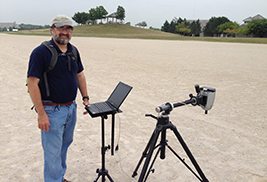Featured Article
Kent State Celebrates Homecoming, Oct. 18
Kent State will celebrate Homecoming on Saturday, Oct. 18, with the theme “Kent State Pride is Worldwide.”
read moreMonitoring Lake Erie’s Algae From Space
Posted Oct. 6, 2014 | Cindy Weiss
Kent State University Geology Professor Joseph Ortiz,
Ph.D., stands next to a hyperspectral, visible
spectroradiometer, used to measure algae, at Maumee Bay
State Park on Lake Erie last summer.
Over the vast expanse of Lake Erie, sampling the water to test for potentially toxic algal blooms may seem like using a medicine dropper in an ocean. It takes days to collect enough data from enough spots to determine if the algae pose a danger.
To cover a larger area more efficiently and better predict future algal blooms, Joseph D. Ortiz, Ph.D., professor of geology in Kent State University's College of Arts and Sciences, is gathering data from an instrument on board the International Space Station — a hyperspectral imager. From space, it can image the entire lake in two days. In his laboratory at Kent State, he breaks down the signal from space and compares it with water samples gathered directly from the lake and analyzed with a similar instrument in the field. Different pigments absorb and reflect light differently; he looks for pigments such as chlorophyll, the green pigment present in many algae.
He then applies statistical methods to determine the amount of algae, its scope and its potential effect on water quality.
During last summer’s toxic algal blooms, leading to a shutdown of Toledo’s water supply, Ortiz was part of a NASA-led group of researchers monitoring the problem. He helped to coordinate field sampling among groups that included the U.S. and Ohio environmental protection agencies, other universities and governmental agencies.
Ortiz is one of the featured speakers at the Second Annual Water Research Symposium at Kent State on Oct. 31, “Water Infrastructure and Rebounding Cities.” He will describe his remote sensing identification of algae in a symposium session on “The Ecology of Water and the Great Lakes.” The symposium is co-sponsored by the Cleveland Water Alliance and the Northeast Ohio Regional Sewer District. Learn more.
A marine geologist with an interest in geological oceanography, climate change and aquatic biology, Ortiz first used remote sensing as a graduate student at Oregon State University and later as a research scientist at the Lamont-Doherty Earth Observatory at Columbia University. He is among a small group of researchers worldwide using remote sensing technologies to study marine sediment recovered from deep-sea cores.
When he came to Kent State in 2001, he began applying these methods to study lakes. Lakes pose more problems for visible remote sensing than oceans because they have more complex mixtures of organic matter and sediment that can muddy the waters, so to speak.
Last summer, the NASA Glenn Research Center in Cleveland flew a research airplane at 11,000 feet and lower over Lake Erie’s Western Basin to collect high-resolution images of the lake during the height of the algae crisis. Information from those flights helped Ortiz learn how atmospheric aerosols can skew remote sensing results from space. The data collected last summer will allow researchers to make atmospheric corrections.
In the future, it may be possible to develop new and updated algorithms to predict the nature of phytoplankton blooms— not all algal blooms are toxic — in order to better understand how algae respond to different temperatures and levels of nutrients in the lake, he says. Scientists are still studying why last summer’s algal bloom was so bad. It did not extend as far as the 2011 bloom, and it was more diffuse, spreading with the persistent rain. It developed quickly after a delay possibly caused by the cold winter.
His research will help provide a baseline profile that can be used to assess the effectiveness of any measures taken to slow algae growth. Limiting fertilizer run-off into the lake, reducing phosphorus and repairing combined sewer overflow systems are among the suggested solutions.
Ortiz also studies blue-green algae in Grand Lake St. Mary southwest of Toledo, the largest inland lake in northwest Ohio and one that has five times higher microcystin levels — the toxin that tainted the water in Toledo— than Lake Erie. The dominant blue-green alga in Grand Lake St. Mary is a different type than that found in the Western Basin of Lake Erie, although both can produce microcystin. Understanding how they differ will help improve their identification by remote sensing methods.
Ortiz’s talk at the university’s Second Annual Water Research Symposium at 8:45 a.m. on Oct. 31 at the Kent State Hotel and Conference Center will lead off the meeting. Other speakers will talk about the latest research on water policy, green design and urban infrastructure and stormwater issues.
Keynote speaker David Sedlak, Ph.D., director of the Institute for Environmental Science and Engineering at the University of California, Berkeley, will talk about the need for innovation in urban water infrastructures. Bill Shuster, Ph.D., research hydrologist with the U.S. Environmental Protection Agency, will speak about the role of a new urban water cycle in sustainability. Kelli Rotunno, director of engineering and construction for the Northeast Ohio Regional Sewer District will discuss CSOs, or combined sewer overflow systems. The program also features Kent State faculty presenting findings on water policy, green design, hydrology and managing pollutants.
The symposium is free and open to the public. Register today.
Learn more about Ortiz’s research.
